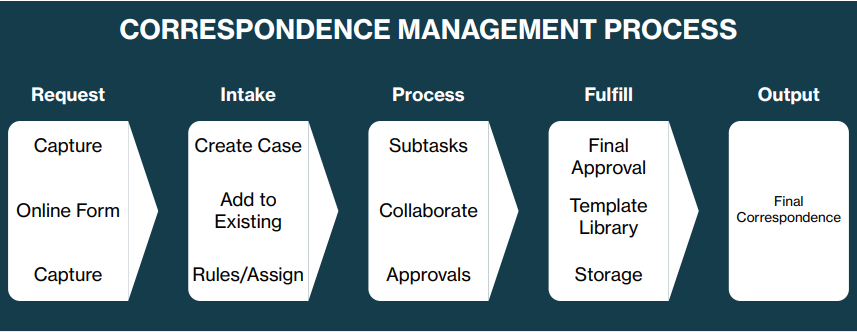What is Correspondence Management?
Correspondence management occurs in all organizations. To function, organizations must engage in correspondence to perform critical daily functions. Correspondence is how work is assigned, initiated, and completed; it is the communication used to get work done. In general terms, correspondence includes letters, faxes, invoices, memorandums, requests for information, project design reviews, agendas, change-orders, emails, project manager notes/instructions, etc.
Depending on the industry and type of organization, correspondence can encompass different meanings. For example, government agencies might have congressional, citizen, and inter-agency requests, as well as the Freedom of Information Act (FOIA). Some agencies and organizations are processing appeals, claims, or complaints. Others are processing internal and external compliance inquiries and audits. Regardless of the agency or type of correspondence, all correspondence requires appropriate action in the form of redirection, review, approval, and/or archiving in a timely and organized fashion.
Correspondence management is managing a request from an external source through a collaborative process, routing, and tracking it to completion—i.e., it is request fulfillment. Correspondence management enables workers to create audit trails of received correspondence, reducing errors and saving valuable time. To adhere to industry standards and government regulations regarding response time requirements, organizations need to streamline and automate how these requests are processed and completed. A correspondence management system (CMS) standardizes processes and streamlines/centralizes an organization’s internal and external communications, enabling officials to perform more critical tasks in a productive, efficient manner.

How Does Tasker Facilitate Correspondence Management?
Tasker eliminates chaos by moving organizations away from email, spreadsheets, shared folders, and complex workflow solutions.
With Tasker, users can easily create, assign, delegate, route, and manage tasks for any ServiceNow workflow. New tasks can be assigned in one-click, and existing tasks can be reviewed and approved. Users can automate scheduled tasks and transform and consolidate email requests, spreadsheets, and attachments into trackable and reportable tasks.
Tasker enables users to manage data and content within the unique requirements of any industry or agency. Particularly in government agencies, correspondence can contain sensitive data. Tasker’s flexibility allows for different requests to be easily updated to accommodate different processes while maintaining document security, protecting confidential information and personal identifiable information (PII). Through DTech Apps’ partnership with ServiceNow, all versions of Tasker have inherited FedRAMP High and U.S. Department of Defense (DOD) Impact Level 5 (IL5) Provisional Authorization through the ServiceNow National Security Cloud (NSC).
How Does DocIntegrator Facilitate Correspondence Management?
DocIntegrator integrates access to Microsoft® SharePoint with any ServiceNow environment. Users can create, edit, review, and digitally sign files and documents—including metadata—stored in SharePoint directly inside of Tasker and any ServiceNow workflow or solution, including any ServiceNow Workspace solution. All these features and functionalities can be executed in real-time without ever leaving ServiceNow or Tasker or going into the SharePoint application itself.
DocIntegrator leverages SharePoint’s native features of version control and document security, helping protect PII and other confidential information without having to download and upload new versions. DocIntegrator integrates easily with Tasker. Users can search, view, and work on all documents related to a task and attach documents directly to tasks in Tasker while keeping the documents secure and safe in SharePoint. Maintenance of SharePoint’s robust security permissions ensures only the right users can access libraries and content they have been given access to.
Freedom of Information Act (FOIA) Use Case
The Freedom of Information Act (FOIA) provides the public the right to request access to records from any federal agency. FOIA is the law that keeps citizens in the know about their government. Federal agencies are required to disclose any information requested under FOIA, unless it falls under one of nine exemptions which protect interests such as personal privacy, national security, and law enforcement.
Tasker can be used to facilitate and carry out the lifecycle of FOIA requests. Tasker streamlines correspondence in the form of requests via web forms, e-mails, and faxes and transforms them into documented tasks. Once these forms are submitted, they are routed through to the proper personnel to assess the information requested and determine what materials can be provided for public distribution. Requests are then approved and fulfilled within deadlines with the help of automation. Any documents related to a task for an information request can be attached directly to tasks in Tasker while remaining secure and safe in SharePoint.